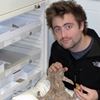General Description
Males have dark brown upperparts and cream to white underparts. Females and young males have fawn to silvery-grey upperparts and fawn underparts. Younger males may also have spots on their chest. Cream whiskers. Pups are chocolate brown. Up to 2.5 m long.
Biology
Australian Sea Lions are one of the rarest seal species in the world and are only occasionally seen along the Victorian coastline. Breeding occurs every 18 months and young are born at various times over a six month period. Pups often form groups in rock pools. Australian Seal Lions also swallow small stones, which is thought to provide weight balance when diving for food. They are preyed upon by Great White Sharks.
Humans interactions include:
Populations on Kangaroo Island are a major tourist attraction.
Habitat
Coastal and continental shelf waters, sandy beaches, to depth of 40 m.
Open water
Distribution guide
Western Australia to islands of southern Australia, including Tasmania. Potentially near Port Phillip, recorded from Victoria.
Species Group
Depth
Shore (0-1 m)
Shallow (1-30 m)
Deep ( > 30 m)
Water Column
Max Size
2.5 m
Diet
Carnivore
Commercial Species
No
Global Dispersal
Native to Australia
Conservation Status
- DSE Advisory List : Not listed
- EPBC Act 1999 : Vulnerable
- IUCN Red List : Endangered





